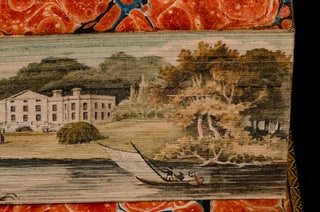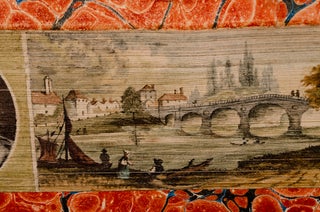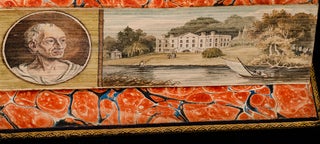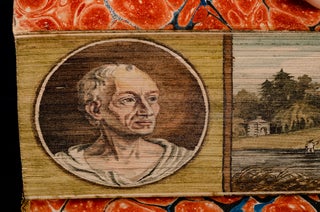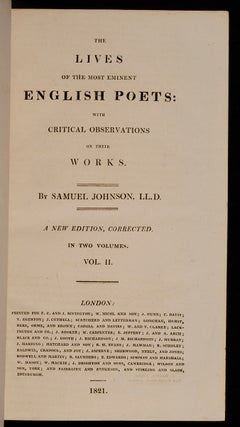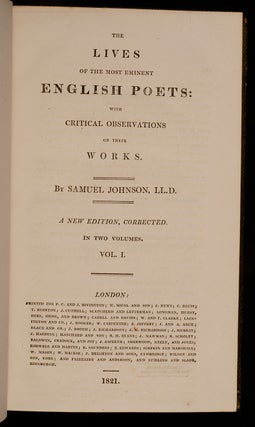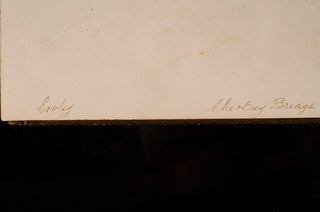Lives of the most Eminent English Poets:, The
London: Printed for F.C. and J. Rivington; W. Nicol and Son…, 1821. Item #05160
With Two Very Fine Fore-Edge Paintings by Helen R. Haywood
Depicting the Homes of Abraham Cowley and Alexander Pope - Both with a Fine Portrait
FORE-EDGE PAINTING. HAYWOOD, Helen R., artist. JOHNSON, Samuel. The Lives of the most eminent English Poets: with Critical Observations on their Works… A New Edition, Corrected. In two volumes. London: Printed for F.C. and J. Rivington; W. Nicol and Son…, 1821.
With two very fine early twentieth century fore-edge paintings by Helen R. Haywood. The first volume with a fine view of Chertsey Bridge and with a portrait of Abraham Cowley on the left side; The second volume with a fine view of Alexander Pope's Villa, Twickenham and with a portrait of Pope on the left-side.
Two octavo volumes (8 3/8 x 5 1/8 inches; 212 x 130 mm.). [viii], [1]-446; [iv], [1]-454 pp.
Full contemporary dark blue calf, covers elaborately decorated in gilt and blind, spines with four shallow raised bands, decoratively tooled and lettered in gilt in compartments, decorative gilt board-edges and turn-ins, red and blue marbled endpapers, all edges gilt. Housed in an early blue cloth slipcase. Gilt on spines very slightly dulled, otherwise near fine.
These fore-edge paintings were done by Helen Haywood sometime between 1927 and 1940. Front flyleaf of volume one with "Cowley" [and] "Chertsey Bridge"; volume two with "Pope" [and] "Pope's Villa, Twickenham" both in the hand of Helen Haywood.
Helen R. Haywood (1908-1995) was an English writer and illustrator of children's books. She was born in England in 1908 but was taken as a child to Chile, where her father, an engineer, worked on the trans-Andean railway. She remained in Chile until she was approximately 15 years old. Her experiences were recounted in an unpublished novel,"Childhood in Chile." Miss Haywood was a keen student of science and an amateur naturalist and anthropologist. Many of the books she illustrated for the publisher Hutchinson & Co., London, were keenly observed and scrupulously accurate depictions of plants, birds and animals. When commissioned to do illustrations for a children's book on dinosaurs, her research into the skin colors she subsequently chose for her dinosaur illustrations was cited by the Royal Academy of Sciences. Haywood was also a practitioner of the art of fore-edge painting. She became acquainted with the art form through an uncle who was associated with the Bayntun-Riviere Bindery of Bath. She did several fore-edge and double fore-edge paintings on commission every year from the 1930s to the 1970s for Inman's Books, an antiquarian book dealer in New York City. She died in Bournemouth, England in 1995.
Abraham Cowley (1618-1667) was an English poet born in the City of London late in 1618. He was one of the leading English poets of the 17th century, with 14 printings of his Works published between 1668 and 1721. Around 1663 Cowley obtained permission to retire into the country; and through his friend, Lord St Albans, he obtained a property near Chertsey, where, devoting himself to botany and books, he lived in comparative solitude until his death.
Alexander Pope (1688-1744) was a poet and satirist of the Augustan period and one of its greatest artistic exponents. Considered the foremost English poet of the early 18th century and a master of the heroic couplet, he is best known for satirical and discursive poetry, including The Rape of the Lock, The Dunciad, and An Essay on Criticism, and for his translation of Homer. In 1719 he moved to Pope's Villa in Twickenham, then a village west of London in Middlesex where he created gardens and an underground grotto. The house and grotto were topics of 18th- and 19th-century poetry and art.
Price: $5,500.00

 I have been in the rare and antiquarian book business for over forty years; my family has been in the rare books business since 1876. Rare books are in my blood.
I have been in the rare and antiquarian book business for over forty years; my family has been in the rare books business since 1876. Rare books are in my blood.

